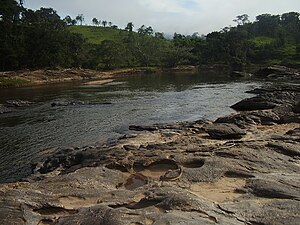| This article needs additional citations for verification. Please help improve this article by adding citations to reliable sources. Unsourced material may be challenged and removed. Find sources: "Santo Antônio River" Doce River tributary – news · newspapers · books · scholar · JSTOR (April 2024) (Learn how and when to remove this message) |
| Santo Antônio River | |
|---|---|
 Santo Antônio River in Santo Antônio do Rio Abaixo Santo Antônio River in Santo Antônio do Rio Abaixo | |
| Physical characteristics | |
| Source | |
| • location | Conceição do Mato Dentro |
| Mouth | Doce River |
| • coordinates | 19°14′S 42°19′W / 19.233°S 42.317°W / -19.233; -42.317 |
| Length | 287 km (178 mi) |
The Santo Antônio River of Brazil rises in the Espinhaço Mountains, in the district of Santo Antônio do Cruzeiro, city of Conceição do Mato Dentro, in the Brazilian state of Minas Gerais. Running to the east, after a journey of 287 km, will pour its waters into the Rio Doce.
The bandeirantes used the river as a transportation route during the Brazil Gold Rush. Today it is used for fishing and gold panning, as well as leisure and tourism.
The Santo Antônio River is notable for its rocky course with a number of waterfalls, including Bahia Falls and Tabuleiro Falls (rated in the 2005 edition of Guia 4 Rodas as the prettiest in Brazil).
Cities of the basin of Santo Antônio River
- Conceição do Mato Dentro
- Morro do Pilar
- Santo Antônio do Rio Abaixo
- São Sebastião do Rio Preto
- Ferros
- Braúnas
- Joanésia
- Açucena
- Mesquita
- Belo Oriente
- Naque
References
- Almeida, Rafael M.; et al. (2019). "Limnological effects of a large Amazonian run-of-river dam on the main river and drowned tributary valleys". Scientific Reports. 9 (1). doi:10.1038/s41598-019-53060-1. PMC 6856549. PMID 31727931.
| Santo Antônio do Rio Abaixo | ||
|---|---|---|
This article related to a river in Minas Gerais is a stub. You can help Misplaced Pages by expanding it. |
